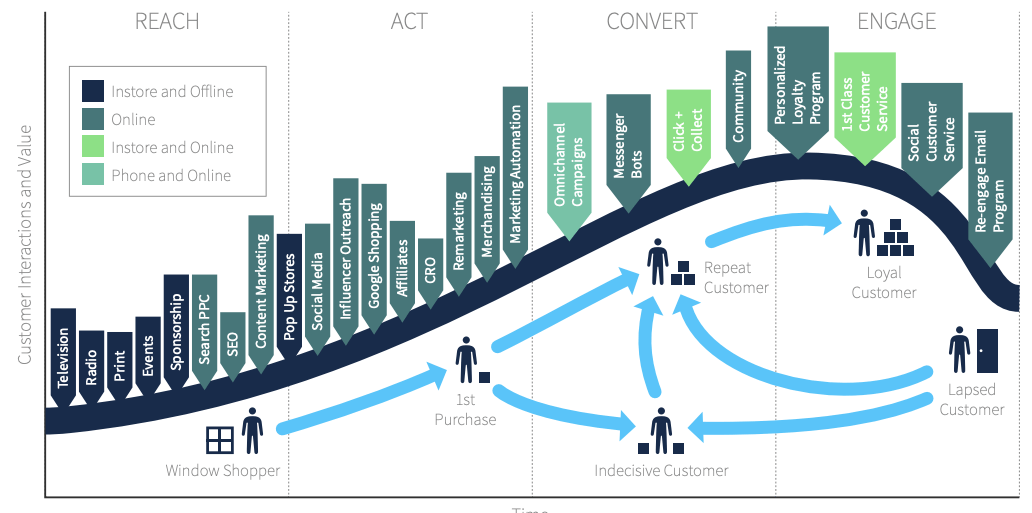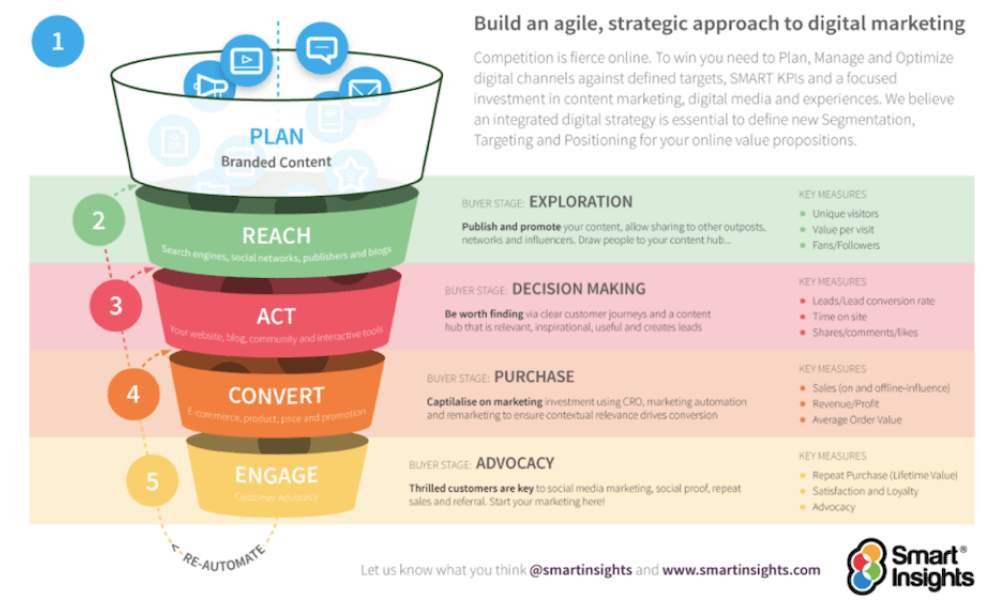A manifesto and ten-point checklist for delivering more relevant online and offline communications
To gain the best results from integrated marketing communications needs a deep understanding of the multiple touchpoints that a brand has with its prospects and customers on its own sites, partner sites digital, and traditional media.
Integrate your marketing communications with the RACE Framework
To fully join up your marketing communications, you will want to consider the focus of your marketing strategy - do marketing activities happen independently, or within a sales funnel, or are they integrated with a structure focused around your customers' omnichannel experiences?
Use the RACE Framework to break this down further, what are the key messages and platforms at each stage of your customers' journeys? Which marketing activities are most efficient at meeting your objectives, what can scale up or down?
Integrated marketing is all about asking these bigger picture questions, and using these insights to plan integrated marketing communications. Our marketing lifecycle model will help you map out your own marketing strategy across reach, act, convert, and engage.

Whether you're looking to audit your marketing communications, optimize your communications planning, or just need some help prioritizing communications channels, I recommend booking a free 1-2-1 consultation call with the team.
Our consultation calls are designed to put you in the driver's seat and talk through your opportunities using the RACE Framework, so you can make an informed decision about the best strategy for your business. Book your call to find out more. Need a winning marketing strategy?
Book your free 1-2-1 consultation to develop your new strategy with the RACE Framework
Book consultation
Requirements for effective integrated marketing communications
In marketing, it's common to say that effective communication is about delivering the right message to the right audience at the right time. That's true, but the reality in multi-channel marketing is more complex. Multi-channel communications are more complex as I show in Digital Marketing: Strategy, Implementation, and Practice. Essentially, what we’re trying to create using paid integrated with other media is
"A Multi-channel Communications Strategy
Customized for Individual Prospects and Customers forming different segments
across a defined customer lifecycle
which...
delivers the Right Message
featuring the Right Value Proposition (product, service or experience)
across different devices (desktop, mobile and tablet)
with the Right Tone
at the Right Time
with the Right Frequency and Interval
using the Right Media / Communications channels
to achieve...
The right balance of value between consumer and brand."
So it's far from easy! I hope the discussion and examples of best practice on this site help with your integrated communications. I'll list the main posts that should help - they're most relevant to email marketing, but as you can see below, the concept can also be extended to include offline communications, search and social media marketing.

Recommended articles to help with Right Touching
Why is integration such a challenge?
I think that integrated comms are our biggest challenge as online marketers since:
- Consumers have limited attention and limited appetite for interaction with brands.
- The growth of smartphone adoption has made omnichannel marketing more critical than ever.
- Marketers have limited budget and resources so they need to try to make every consumer interaction count and engage their audience through effective targeting.
- To market effectively, marketers need to deliver and analyze multiple interactions across digital and traditional media channels, i.e. allocate conversion to the media that have influenced a lead or sale whether these are display ads, paid or natural search, social media, affiliate marketing, email marketing, Direct Mail, TV or print ads.
- Website owners need to test and refine the design, messaging and value propositions that will engage visitors on their fleeting visits so landing page experiments and site optimization using techniques such as AB and multivariate testing become crucial to getting better results.
You can see that to achieve Right Touching or what my colleague Richard Sedley of cScape calls "light touching" requires practical skills in the challenge areas of communications strategy, web analytics, and optimizing the different media above.
So integrated communications require a cross-disciplinary approach for success and I try to concentrate on the major developments in these core digital media which professional marketers such as E-commerce Managers, Digital Marketing Directors and Execs, need to know rather than the noise of minor developments which may be important to specialists but don't really affect the big picture.
Create an integrated marketing funnel
One of the reasons why our RACE Framework is so popular with marketers and managers across the globe and is the practical nature of customer insights with can be quickly identified within the marketing funnel. Simply put, by strategizing their marketing activities within the framework of plan, reach, act, convert, and engage, marketing leaders can quickly integrate and accelerate their customers' journeys to first-time and repeat purchases.

If you're looking for integrated communication solutions to win more customers, why not book your free 1-2-1 consultation call? Your dedicated call will include discussing your marketing strategy in the context of the RACE Framework, identifying weaknesses, opportunities, and solutions to integrate and optimize your marketing communications using the RACE Framework. Book your call now. Need a winning marketing strategy?
Book your free 1-2-1 consultation to develop your new strategy with the RACE Framework
Book consultation
Integrated communications checklist
To what extent are you incorporating integrated marketing communications? Use this
checklist from customer acquisition to retention which covers 'always-on' integrated communications:
- Search marketing: When a prospect uses Google to search on a company brand name plus a specific category or product, a paid search ad should explain the value of the proposition and direct them to the right product page.
- Behavioural targeting or online advertising: When a prospect interacts with content on a media site or searches on a specific term, a sequence of follow-up ads known as behavioural retargeting should be displayed as they visit other sites within a network and the destination site of the merchant paying for the advertising.
- Multi-touches across different digital media channels for acquisition: Using tracking through web analytics to understand the sequence and combination of different digital media channels (search, affiliate, ads, aggregator sites) which generate the most cost-effective response.
- Email welcome strategy: When a prospect subscribes to an email newsletter or enquires about a service, a welcome communications strategy should be in place which uses a sequence of email and possibly personalized web recommendations, direct mail and phone communications to educate the customer about the brand or product and generate the initial sale.
- Reducing online attrition: When a shopper abandons their shopping basket, a combination of communications should seek to win them back. Alternatively, after a quotation, for example for a car policy, follow-up emails should remind customers about the benefits of taking out the policy.
- Delivering relevant recommendations: When an existing customer returns to a site, a personalized container should be available on every page to deliver relevant personalized. Panels within an email can do the same.
- Following up on customer product or promotion interest: When a customer clicks on a link in an email or interacts repeatedly with the content on a site is there an automated workflow triggering and email, direct mail or phone reminder about the process.
- Getting the frequency right: Effective Right Touching requires that messages stay relevant and don't become intrusive because the volume is too high. So you should put limits on the maximum number of emails that are sent in a period (e.g. one a month or one a week) and the interval between them (e.g. an interval
of at least 3 days).
- Getting the channel right: Right channelling means using the best channel(s) for the customer, which fits their preferences and the right channel for the company, which gives them the best combination of cost and response. It means that for some customers you may be able to upweight email communications because they interact and respond to them, so reducing the costs of direct mail. But other customers on an email list may not respond to or dislike email and so direct mail is upweighted to them.
- Getting the offer right: Offers will vary in effectiveness according to the audience targeted and this will be indicated by their profiles and customer journeys indicated by the media and content they have consumed. So right-touching requires that testing is built-in to deliver the right messages and right sequences of communications for different audiences.
Need a winning marketing strategy?
Book your free 1-2-1 consultation to develop your new strategy with the RACE Framework
Book consultation



















